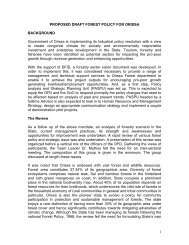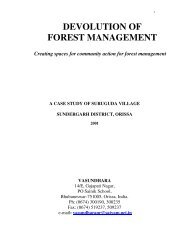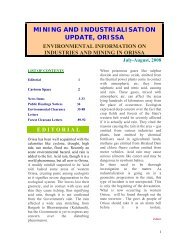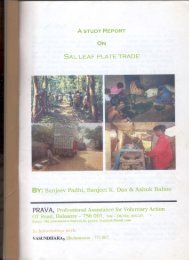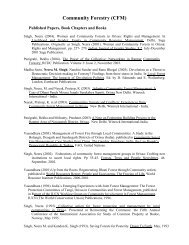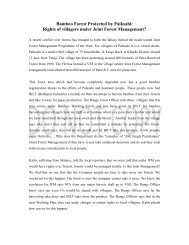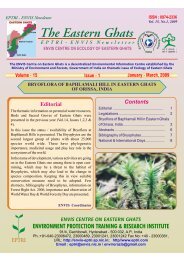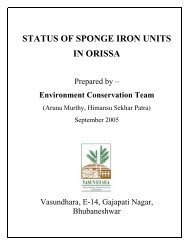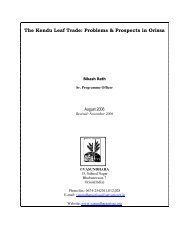Bamboo in Orissa: Trade and Livelihood Perspective - Vasundhara
Bamboo in Orissa: Trade and Livelihood Perspective - Vasundhara
Bamboo in Orissa: Trade and Livelihood Perspective - Vasundhara
You also want an ePaper? Increase the reach of your titles
YUMPU automatically turns print PDFs into web optimized ePapers that Google loves.
All rights reserved by VASUNDHARA(www.vasundharaorissa.org). For any clarification, contact author at sunlit1968@yahoo.co.<strong>in</strong><br />
Bidi peti: the lost charm<br />
About 3000 HHs of bamboo artisans of Bhatara, Munder, Mathapali <strong>and</strong> Talpali etc. were<br />
critically dependant on the bus<strong>in</strong>ess of bbidi-peti supply to the bidi factories of<br />
Sambalpur/Jharsuguda. Almost all of them are l<strong>and</strong>less, <strong>and</strong> whereas traditional items<br />
could fetch them max. Rs.400 to 500 per HH/month, bidi-peti alone helped them earn<br />
Rs.1000 to 1200/month/HH. Hence, they used to concentrate on this item. The dem<strong>and</strong> of<br />
bidi-peti was almost constant(about 10000 per week <strong>in</strong> the two districts, The Statesman,<br />
<strong>Orissa</strong> page, 27-4-04) throughout the year, unlike traditional products; <strong>and</strong> bidi-companies<br />
sometimes used to make their own arrangement to procure the conta<strong>in</strong>ers from them.<br />
Br<strong>in</strong>g<strong>in</strong>g bamboo from the local forest <strong>and</strong> then process<strong>in</strong>g it to make one such conta<strong>in</strong>er<br />
normally takes one man-day <strong>and</strong> the sale price varied from Rs.20 to 22 per piece<br />
depend<strong>in</strong>g on the size. However, s<strong>in</strong>ce about 5 years the bidi-companies have either<br />
reduced or stopped their procurement s<strong>in</strong>ce they say that with the decreas<strong>in</strong>g dem<strong>and</strong> of<br />
bidi, paper-conta<strong>in</strong>ers rather seem to be more affordable than such bamboo-conta<strong>in</strong>ers. As<br />
such, the bidi company that used to procure about 1000 pieces of bidi-peti from the<br />
Turipada hamlet of Munder village, per month; has now stopped procurement from this<br />
village. Few artisans of the neighbour<strong>in</strong>g hamlet Munder Indira Awas have somehow<br />
persuaded another bidi company to take their product as a result of which they are now<br />
able to sell about 60 pieces per month though it is only 10% of the number earlier<br />
supplied. Persuasion succeeded partly at the cost of a lower price(i.e., Rs.16/piece) though<br />
now the company has agreed to pay Rs.20; but this does not mean that there is a dem<strong>and</strong><br />
from the user side.<br />
Almost absolute dependency on bidi-peti left these people <strong>in</strong> lurch after the dem<strong>and</strong> was<br />
lost. They now seek some external help for their livelihood support(per comm.., Tulasi<br />
Behera, Gulu Behera, <strong>and</strong> villagers of Munder Turipada).<br />
Sena has now but few takers. This w<strong>in</strong>now-like product is used for lift<strong>in</strong>g <strong>and</strong> throw<strong>in</strong>g<br />
water often for limited irrigational purposes; but with the grow<strong>in</strong>g use of water pumps, it is<br />
now difficult for the artisans of Gadagopalpur village to sell it at even Rs.30/piece though<br />
the actual price should be more than double. Earlier, <strong>in</strong> each weekly haat the sale rate of<br />
sena was about 10 to 12 pieces per family(artisan); but now there is hardly any sale(per<br />
comm.., Parvati Mallik <strong>and</strong> Jal<strong>and</strong>har Mallik). The production of this item has therefore<br />
decreased to its m<strong>in</strong>imum <strong>and</strong> a day may come when it could be seen only <strong>in</strong> museums.<br />
Oodara/nodara is still used <strong>in</strong> rural areas, but the dem<strong>and</strong> has decreased substantially after<br />
tractor was used to br<strong>in</strong>g construction materials like s<strong>and</strong>, <strong>and</strong> other items of commerce. At<br />
Gania weekly haat, about 80 pieces used to be sold per week three decades ago, but now<br />
there is hardly any sale. Doli that was sold @100 pieces per week at that time has now<br />
reduced to a sale rate of about 25 pieces per month, say the artisans of Gania.<br />
Steel/alum<strong>in</strong>ium drums <strong>and</strong> other substitutes are now available for stor<strong>in</strong>g paddy/rice.<br />
In <strong>in</strong>tra-village bus<strong>in</strong>ess there is almost no scope/role for/of a middleman; but <strong>in</strong> <strong>in</strong>tervillage<br />
bus<strong>in</strong>ess, particularly where the distance between the manufacturer(artisan) <strong>and</strong> the<br />
80



